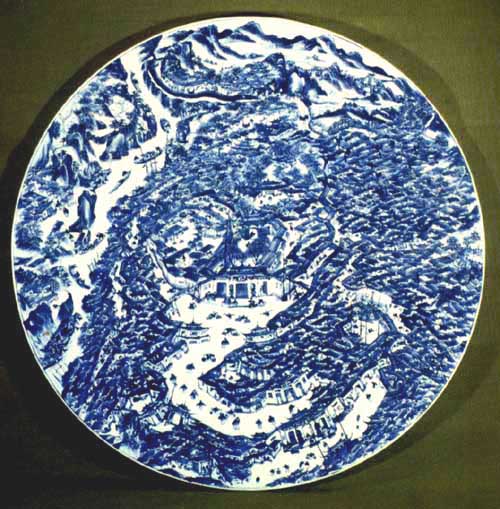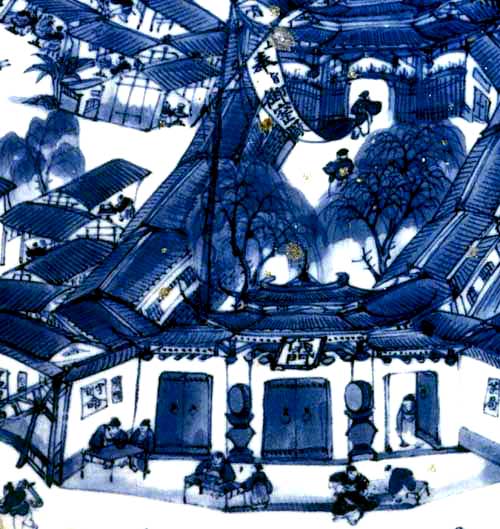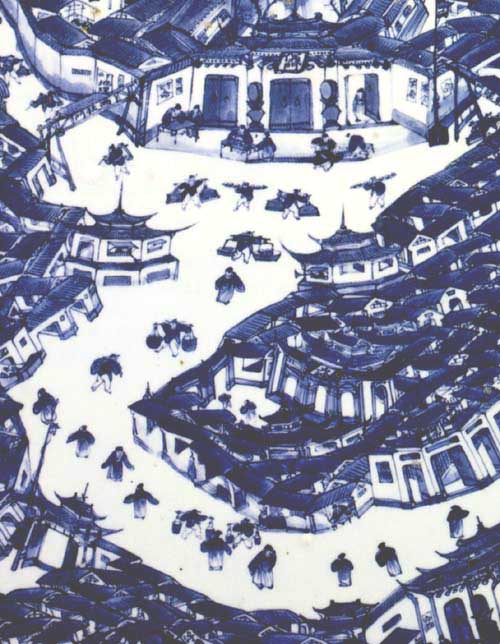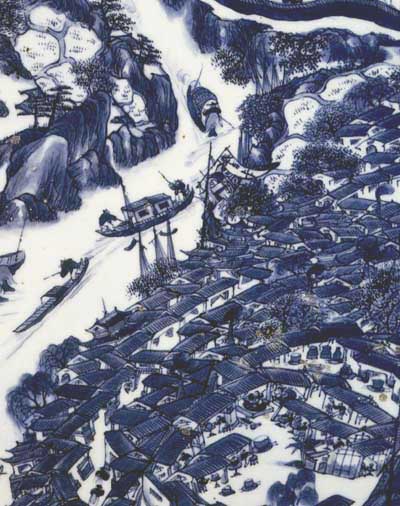This table top (Dia. 72.5 cm) is dated to Qing Daoguang Period. The blue and white decorated picture shows the daily scene in the area around the imperial kiln at Zhushan in Jingdezhen. In picture 2, there is a pole with a floating banner with the words which means the imperial kiln factory. Within the compound, you can see potters engaging in the various ceramics production activities. The bustle of human activities is vividly depicted in picture 3 . Jingdezhen has been a centre of ceramics production since the Song Dynasty. During the time of Emperor Kangxi, the economy of Jingdezhen was been affected during the Wusangui rebellion. Serious damages were inflicted on the area. Emperor Kangxi ordered the rebuilding of the Jingdezhen porcelain factory in 1682 . A superintendent of the kilns was personally appointed by the emperor to oversee the operation of the imperial kilns. At the same time, the system of forced labour was changed to paid craftsmen and labourers. Following the reorganisation, basically two level of production existed. One was the production of imperial porcelains by the imperial kilns supervised by a superintendent to meet the needs of the palace, The other level is the folk kilns which produced porcelain wares for the domestic and foreign markets. The economy of Jingdezhen took off and prospered from then. We could get a glimpse of the prosperity through the letter written by the celebrated French Jesuit Father d'Entrecolles in Sep 1712. In it, he wrote: "There are reckoned to be eighteen thousand families in Jingdezhen. There are large merchants whose lodgings occupy a vast area; but it is also commonly said that there are over a million souls, and that over ten thousand loads of rice are consumed every day and more than a thousand pigs. Moreover Jingdezhen extends for a great way alongside a fine river ……. The streets are as straight as a taut cord and cross one another at regular intervals……" " The expenditure is considerable because everything that is consumed must be brought in from outside, including the wood needed to fuel the fires in the furnaces. However, in spite of the cost of living, Jingdezhen is a sanctuary for numberless poor families….; employment is found there for young people and the infirm. Even the blind and the disabled can make a living by grinding up the colours. In ancient times, only 300 furnaces could be counted there, now there are at least three thousand......" "Jingdezehn is situated on a plain surrounded by high mountains; those that are to the east form a sort of a semi-circle in the background; from the mountains at either side flow two rivers, which join into one another. One is quite small, but the other is very large and forms a fine harbour, more than a league long ,running into a wide basin, where it flows much less fast. In this wide space one sometimes sees as many as two or three lines of boats tied end to end ....." ".... At nightfall one seems to be looking at a hugh city aflame, or at an enormous furnace with many vents ... The police there are admirable; each street has an officer appointed by the Mandarin ... each officer has ten subalterns, each of whom is responsible for ten houses. They must maintain good order, hasten at the first sign of any commotion, quell it and advise the Mandarin under pain of the bastinado, which is administered very liberally here. Each street has its barricades that are close at night .... Furthermore strangers are rarely allowed to sleep in Jingdezhen; they must either spend the night on their boats, or lodge with people of their acquaintance who must answer for their conduct." Jingdezhen is situated next to Changjiang river
which through a network of rivers and waterways is linked to Beijing.
The porcelain cargo for the Palace were transported to Beijing through
the water network. A scene showing boats on the river is shown
in picture 4.
|
||||
|
|



